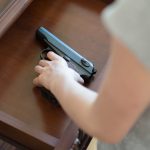When a child unintentionally shoots and kills another child in the United States, they’ve likely been playing around with an unlocked, loaded gun, new research reveals.
Analyzing a decade’s worth of data, researchers also found that 4 out of 10 such gun deaths involve kids 2 to 4 years old. About two-thirds of the unintentional fatal shootings happen at the victim’s home, and both victim and shooter are usually male.
Nearly all cases “involve a gun belonging to a parent or other family member that was stored loaded and unlocked,” said study co-author Nichole Michaels.
“Often, the child was playing with the gun or thought the gun was a toy,” noted Michaels, an assistant professor of pediatrics at the Ohio State University College of Medicine and the Center for Injury Research and Policy at Nationwide Children’s Hospital in Columbus, Ohio.
The critical message is that “these deaths are preventable, and safe storage of firearms is the key,” Michaels said.
Guns have surpassed road crashes as the leading cause of death among American children and teens, according to a recent study using data from the U.S. Centers for Disease Control and Prevention.
In the new study, investigators used data from the National Violent Death Report System (NVDRS), looking at 279 unintentional fatal shootings that occurred between 2009 and 2018. All the cases involved kids younger than 15 who accidentally killed themselves or another child with a firearm.
“One thing that really struck me about these cases,” Michaels said, “was that so many of the victims were toddlers and very young children. Among children who unintentionally shot themselves, 61% were younger than 5 years old.”
The state-based NVDRS pools information from coroner and medical records, law enforcement reports and death certificates. The new analysis included information from the 33 U.S. states that had cases of unintentional gun deaths involving victims under age 15.
Among the other findings:
- More than half the deaths (nearly 57%) were self-inflicted, at an average age of about 6. That figure hit 80% among children under 5.
- In cases where one child shot another, the shooter’s average age was just under 10, with two-thirds between 10 and 14 years old. About half the time the shooter was the brother of the child who died.
- More than 92% of the shooters were male, about half were white, and 28% were Black.
- Based on available data, the team found that in 92% of cases the gun was kept loaded and unlocked.
- Roughly 60% of the time, the gun owner was the parent of the child who used it; about 20% of the time the gun belonged to another family member.
- In one third of cases among 10-to 14-year-olds where two people were involved, the shooter was a friend of the victim’s.
- Nearly three-quarters of the implicated firearms were handguns.
“Our findings also highlight that these incidents overwhelmingly involve boys, and that pattern appears earlier than you might expect,” Michaels noted. “By 2 years of age, roughly 90% of victims were male.”
“Culturally, we know boys are more likely to play with toy guns,” she added. “However, more research is needed to understand whether there are other differences in things like parenting practices that may also play a role in allowing young boys to access firearms.”
Keeping kids safe
Adults have a responsibility to keep children safe, and that means keeping them out of the hands of children, Michaels said.
“If removing firearms from the home isn’t an option, firearms should be stored unloaded and locked away separately from ammunition,” she advised. “Parents sometimes think they can simply ‘hide’ their firearms or teach their children not to touch them. That’s not safe storage. Kids are naturally curious.”
Ari Davis is a policy adviser with the Center for Gun Violence Solutions at Johns Hopkins University in Baltimore.
“Any child in a home with a firearm that is left unlocked and loaded is vulnerable,” said Davis, who was not involved with the new study.
“If you choose to own a gun, always store it unloaded and locked,” he added. “Your child is more knowledgeable than you might expect about how and where you store your gun. They can climb onto counters to reach high shelves, or search through your bedroom dresser. So when you are not using your firearm, immediately lock it up, ideally in a gun safe.”
Another word of caution: “Before your child goes on a playdate at a friend’s house, learn more about the safety practices of the parents, including whether they own firearms and how they keep their guns stored,” Davis suggested. “You can frame the question about gun storage as part of a larger safety discussion and start by bringing up other safety concerns like food allergies, playing outside in the neighborhood, and computer use.”
The findings were published June 26 in Injury Epidemiology.
More information
There’s more on children and gun violence at the Pew Research Center.
SOURCES: Ari Davis, policy adviser, Center for Gun Violence Solutions, and DrPH candidate, Bloomberg School of Public Health, Johns Hopkins University, Baltimore; Nichole L. Michaels, PhD, assistant professor, pediatrics, Ohio State University College of Medicine, and Center for Injury Research and Policy, Abigail Wexner Research Institute, Nationwide Children’s Hospital, Columbus, Ohio; Injury Epidemiology, June 26, 2023
Source: HealthDay
Copyright © 2025 HealthDay. All rights reserved.



-300x169.jpg)












